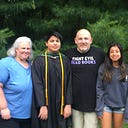Antisemitism: A Gateway to Violent Extremism
As a society, we like to talk about the need to combat intolerance. Despite all of this talk, though, we still seem to be fairly tolerant of antisemitism. When tropes and hate are expressed by people like Kanye West and Kyrie Irving, we hear the excuses and the justifications for their hate. When federal politicians go anti-Israel, complete with a full portfolio of Jewish and Israeli attacks, we praise them for speaking truth to power. And when we see data highlighting a significant increase in antisemitic incidents in the United States, we are far too silent.
Earlier this month, the Anti-Defamation League released its annual audit of antisemitic incidents. In 2022, there were 3,697 documented incidents in the United States, the highest number, by far, in the last decade. Over the last four years, the number of incidents has nearly doubled. From just 2021 to 2022, we saw more than a 20-percent jump in the number of incidents. And this is assuming that local law enforcement is accurately sharing hate crime statistics with the FBI, and not underreporting incidents, as many suspect.
For those that may believe that antisemitism is an “old school” form of hate from days gone by, being replaced by the political extremism we’ve seen in Charlottesville and January 6, they’d be wrong. In fact, the ADL reports a 50-percent increase in antisemitic incidents in K-12 schools, and a 40-percent increase on postsecondary campuses. So the latest generations of haters and violent extremists continue to engage in antisemitism, adding the other flavors of hate they may also express.
There is no refuting that acts of extremism, including public displays of antisemitism, are on the rise. If we are serious about addressing issues of antisemitic-driven extremism, we have to ask WHY we are seeing such increases in hate these days.
First, the number of antisemitic incidents are increasing because violent extremism overall is increasing. In recent years, anti-Black, anti-Asian, anti-LGBTQIA+, anti-immigrant, anti-undocumented immigrant, anti-government, and other popular versions of hate are on the rise. We hate when we are scared. We hate when we think we are being denied what is rightfully ours. We hate when we are struggling. And historically, the Jewish community is one of the easiest targets for such hate. As our frustrations and fears grow, we need targets.
Second, our physical isolation — originally driven by Covid — resulted in the perfect storm for spreading mis, dis, and mal-information. As a society, we embraced conspiracy theories, seeking others to blame for what we were experiencing. Living much of the last few years online, it was easy to find hate and conspiracy theories that aligned with our experiences and fears. With so many of those theories rooted in antisemitic ideas, overt conspiracy theories served as a gateway to full-blown antisemitism. We can see it today, from both the political left and right, as Jewish “power” is to blame for everything from our international policy priorities to the agendas of big-city district attorneys.
And finally and most directly, antisemitism has become mainstream again. Online expressions of antisemitism are more prominent than they have ever been, thanks to rapid growth of everything from social media to memes. While in years past many sought to keep their extremism and their biases closeted, today there is little shame in voicing one’s extremism and publicly acting on it. Conspiracy hosts like Qanon — which is built on antisemitism — have become mainstream, with even non-violent extremist soccer moms spreading tropes. It is now socially acceptable, and even encouraged, to spew hate speech as part of our social and political positioning.
Nearly three years ago, following the death of George Floyd, our civil society spoke out against anti-Black racism and extremism. As other incidents of discrimination occurred, we similarly stood against anti-Asian hate, anti-undocumented immigrant rage, and anti-LGBTQIA violence. Demonstrations against hate and intolerance have increased almost as much as we have seen incidents of violent extremism.
Despite this social awakening, though, we have seen less public outcry about the increase in antisemitism. Whether it is because we are more tolerant of the attacks, more accepting of the hate speech, or more blind to the physical manifestations of antisemitic hate, antisemitism often fails to outrage us as it should.
We should not publicly tolerate violent extremism, no matter what group is the target. We must not allow society to rank flavors of hate, finding some more acceptable than others. We cannot allow violence committed to advance political, social, religious, or ideological beliefs to continue, unconfronted or uninterrupted. And we should brand antisemitic violent extremism as the domestic terrorism it is.
We can turn a blind eye to the data, thinking that if antisemetic incidents are so problematic that we would see coverage of them in the media far more than we do. Or we can realize the hard truth that antisemitism is a gateway to violent extremism. And that acting in the name of antisemitism is domestic terrorism. If there was ever a canary in the coal mine with regard to the growth of extremism in the United States, the ADL data is it.
Antisemitism is a clear and present danger to our nation. The latest ADL data shows it is a danger on the rise, largely ignored by a society demanding greater tolerance. If we seek a nation that allows people to change and contribute to a society without violence and hatred, then we must stand up in opposition to antisemitism in the clearest and strongest ways possible.
